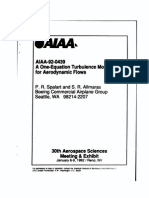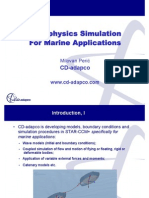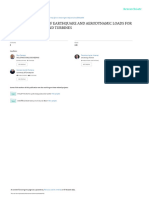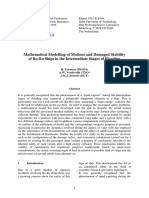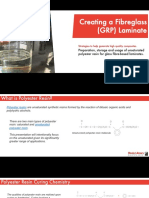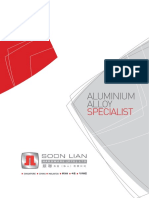Final Format IJSCT92
Uploaded by
Kelvin XuFinal Format IJSCT92
Uploaded by
Kelvin XuSee discussions, stats, and author profiles for this publication at: https://www.researchgate.
net/publication/269100491
Fifty Years of the Gawn-Burrill KCA Propeller Series
Article in The International Journal of Small Craft Technology · September 2009
DOI: 10.3940/rina,ijsct.2009.b2.92
CITATIONS READS
4 4,456
3 authors:
Dejan Radojcic Aleksandar Simić
University of Belgrade University of Belgrade
81 PUBLICATIONS 216 CITATIONS 34 PUBLICATIONS 110 CITATIONS
SEE PROFILE SEE PROFILE
Milan Kalajdzic
University of Belgrade
25 PUBLICATIONS 96 CITATIONS
SEE PROFILE
Some of the authors of this publication are also working on these related projects:
Ultra shallow-draught inland vessels View project
Reflections on Power Prediction Modeling of Conventional High-Speed Craft View project
All content following this page was uploaded by Milan Kalajdzic on 22 January 2015.
The user has requested enhancement of the downloaded file.
Trans RINA, Vol 151, Part B2, Intl J Small Craft Tech, 2009 Jul-Dec
FIFTY YEARS OF THE GAWN-BURRILL KCA PROPELLER SERIES
D Radojčić, A Simić and M Kalajdžić, University of Belgrade, Serbia
(DOI No: 10.3940/rina.ijsct.2009.b2.92)
SUMMARY
The first extensive systematic tests of flat-faced segmental-section propellers were those performed by Gawn in 1953
(open-water tests) and Gawn and Burrill in 1957 (cavitating environment). Since then several attempts to develop
mathematical representations of propeller hydrodynamic characteristics (thrust coefficient KT and torque coefficient KQ)
have been made in order to improve computer capabilities in predicting propeller performance. The first mathematical
model was that of Blount and Hubble (1981), which was soon followed by Kozhukharov’s (1986) and then Radojcic’s
(1988). These models were developed through application of multiple regression analysis. Koushan (2007) challenged
more than 20 years of the regression approach, for representing the highly non-linear Gawn-Burrill KCA propeller
characteristics, and suggested application of the artificial neural network technique. This paper compares the four
mathematical models mentioned above.
NOMENCLATURE regime (represented by a relatively simple set of
equations). This model was followed by Model 2
DAR developed area ratio (Kozhukharov [4]) with single equations for both
EAR expanded area ratio regimes which had 121 and 116 polynomial terms for KT
J advance coefficient and KQ respectively. In order to reduce the number of
KT thrust coefficient terms and increase the accuracy of previous models,
KQ torque coefficient Radojcic [5] published separate equations for non-
ΔKT KT reduction for cavitating conditions cavitating and cavitating regimes, Model 3, the first
ΔKQ KQ reduction for cavitating conditions having only 16 and 17 and second 20 and 18 polynomial
P/D pitch ratio terms respectively. The mathematical models mentioned
Qc torque load coefficient above were developed using multiple regression
z number of propeller blades techniques. Recently, Koushan [6] challenged more than
η0 propeller efficiency 20 years of the regression approach for representing
ηatm propeller efficiency non-cavitating conditions highly non-linear Gawn-Burrill KCA propeller
ηcav propeller efficiency cavitating conditions characteristics, and suggested application of the artificial
σ cavitation number based on advance velocity neural networks (ANN) technique. Koushan derived
σ0.7R cavitation number based on resultant water separate equations for the non-cavitating and cavitating
velocity at 0.7 radius conditions, Model 4, with 34 equation terms for both KT
τc thrust load coefficient and KQ for the non-cavitating regime, and 89 and 107
terms respectively for the cavitating regime.
1. INTRODUCTION
It should be noted that only Model 1 was based on AEW
Flat-faced, segmental section propellers are relatively data (for non-cavitating, i.e. open-water conditions),
simple to manufacture, easy to repair and have while Models 2, 3 and 4 were based on KCA data (for
respectable open-water and cavitation characteristics. atmospheric and cavitating conditions). AEW propellers
These are the main reasons they are still widely used for are geometrically close to KCA propellers – see [1] and
small, high-speed craft. Amongst the first systematic [2]. Data for cavitating conditions of Model 1 are based
tests of these propellers were those performed by Gawn on various sources, see Blount & Hubble [3]. Moreover,
in 1953 [1] (open-water tests) and Gawn and Burrill in it is often assumed that open-water and atmospheric
1957 [2] (cavitating environment). conditions are the same, although that is not the case (this
discussion, however, is beyond the scope of the paper).
Several attempts to develop mathematical representations Consequently, Model 1 should inherently produce
of propeller hydrodynamic characteristics (thrust slightly different results from Models 2 to 4. Common
coefficient KT and torque coefficient KQ) have been for all models, however, is that they are applicable for 3-
made in order to improve computer capabilities in bladed segmental section propellers under cavitating and
predicting propeller performance. The first mathematical non-cavitating conditions.
model, denoted here as Model 1, was that of Blount and
Hubble [3]. They derived separate equations for open- The primary purpose of this paper is to compare the
water characteristics, based on Gawn’s Admiralty mathematical models mentioned above. In addition, an
experiment works (AEW) data (actually polynomials of analysis of results of two decades old regression
the B series propeller form were used with 39 and 47 techniques and those of the more modern artificial
terms for KT and KQ respectively, but new regression neural network technique is given.
coefficients were evaluated), and for the cavitating
©2009: The Royal Institution of Naval Architects
Trans RINA, Vol 151, Part B2, Intl J Small Craft Tech, 2009 Jul-Dec
2. DISCUSSION OF THE MODELS taken into account, then wrong modeling conclusions
may be reached. This is explored in depth in [5],
The exact mathematical models are explained in detail in resulting in a tedious (iterative) model-building process
the references mentioned above. Table 1 provides a side- and selection of the KT and KQ pair that produced the
by-side summary of their principal attributes and optimum ηo representation (note however, that the
respective boundaries of applicability. Note that: chosen KT and KQ equations of Model 3 were not
necessarily the best ones from the statistical point of
• According to Model 1 and Model 3 the non-cavitating view). This seems to have been overlooked in Model 2
regime is valid all the way through to the inception of and later Model 4, resulting in cases that may produce
cavitation - intersection of open-water and transition inconsistent values of ηo. In order to emphasize this
zone (KT and KQ breakdown points). point, in this paper most figures show just ηo. The quality
• Model 4, however, consists of separate equations for the of each mathematical model (the validity and accuracy of
cavitating and non-cavitating regimes for the whole J- KT and KQ curves) was thoroughly checked and
range (which is actually not based on physical facts). discussed in the original papers. All of them show KT
• Model 2 is based on a single equation for both cavitating and KQ curves, but only some of them show ηo values,
and non-cavitating regimes, which is correct in principle although KT and KQ are by definition linked by ηo. So,
but may lead to serious instabilities due to the very large small variations (modelling errors) in independently
number of polynomial terms (121 and 116 for KT and KQ evaluated KT and KQ, as well as possible
respectively). inconsistencies, are emphasized through ηo.
In spite of being derived independently, KT and KQ are
related – linked – via ηo = KT·J / KQ·2π. If this is not
Figure 1: Inconsistencies of ηo values of Model 4 compared to Model 3 (DAR=0.5, non-cavitating)
©2009: The Royal Institution of Naval Architects
Trans RINA, Vol 151, Part B2, Intl J Small Craft Tech, 2009 Jul-Dec
Figures 1 and 2 illustrate the inconsistencies of Model 4 Figure 4 illustrates the outcomes of the three approaches:
(ANN approach) compared to Model 3 (regression
method). The relatively unusual lower diagrams showing • Model 2 – single equation for both cavitating and
J=f(P/D) correspond to the upper 3D diagrams non-cavitating regimes;
ηo=f(P/D,1J) and show the projection of the ηo surface – • Model 4 – separate equations for each regime;
which is supposed to be smooth – in the J-P/D plane. • Model 3 – equations for open-water up to cavitation
Related instabilities of Model 2 are shown in Figure 3. inception, then new equations for cavitating regime.
The local maxima/minima and saddle points shown are
obviously not desirable. Model 1, being a bit different but having the same
approach as model 3, is shown in Figure 5. Note the
It should be noted however, that the database of the lower boundaries of applicability for the cavitating
original KCA propeller series also showed some regime (going down to J=0.4) compared to those of
inconsistencies (disagreements of KT, KQ and ηO, see [5]) Models 2 to 4 (shown in Figure 4).
which probably may be explained with the fact that
diagrams published in [2] were too small. This collateral Although not explicitly shown by the original KCA
conclusion actually shows the power of regression dataset, it is sometimes possible to obtain slightly higher
analysis and curve fitting methods which weres not used efficiencies under cavitating than under non-cavitating
in the fifties when KCA test data were faired/drawn. As conditions. Nevertheless, all models that are shown in
the KCA data used for building Model 3, and most Figure 4 are based on the same KCA dataset, so higher
probably for Models 2 and 4 too, were not “the raw (peak) efficiencies under the cavitating conditions
measurements data”, but were data obtained through the (obtained by Models 2 and 4) may be explained only with
digitization of curves presented in relatively small unsatisfactory ηo presentation/accuracy (at least for
diagrams [2], reading errors of up to 5% were possible. particular DAR and P/D values), as evaluated values,
Figure 2. Inconsistencies of ηo values of Model 4 compared to Model 3 (DAR=0.8, σ=1.00)
©2009: The Royal Institution of Naval Architects
Trans RINA, Vol 151, Part B2, Intl J Small Craft Tech, 2009 Jul-Dec
Math. Recommended Additional
General Equation Boundaries of applicability
Model Boundaries
For non-cavitating conditions (Based on AEW data) For non-cavitating conditions
39
s1 t1 u1 v1
KT = ∑ CT1 × ( J ) × ( P ) × ( EAR) × ( z )
( D ) z = 3 and 4
n =1 0.60 ≤ P/D ≤ 1.60
47 t1 0.50 ≤ EAR ≤ 1.10
× ( EAR )u1 × ( z )v1 ⎞⎟ 0.80 ≤ P ≤ 1.40
K Q = ∑ ⎛⎜ CQ1 × ( J ) s1 × P
D ( ) ⎠ D
n =1 ⎝
CT, CQ, s, t, u, v - coefficients for non-cavitating conditions
For cavitating conditions (Based on various sources) For cavitating conditions
KT = 0.393 × τ c × EAR × (1.067 − 0.229 × P ) × ( J 2 + 4.836)
D 0.60 ≤ P/D ≤ 2.00
K Q = 0.393 × Qc × EAR × (1.067 − 0.229 × P ) × ( J 2 + 4.836)
D
For transition region:
τ c = 1.2 × σ 0.7 R
0.9
(0.7 + 0.32× EAR )
Qc = 0.2 × P × σ 0.7 R
Model 1 – Blount & Hubble [3]
D
or fully developed cavitation:
τ c = 0.0725 × P D − 0.034 × EAR
2
0.0185 × P ( D) − 0.0166 × P + 0.00594
Qc = D
3
EAR
Single equation for non-cavitating and cavitating conditions
(Based on KCA data) 0.60 ≤ P ≤ 2.00 for σ < 0.75:
⎛ a1
⎞ b1 D (P/D)min > 0.85
⎛ J − 0.30 ⎞ ⎛ ln(arctg (σ )) ⎞
⎜ A1 × ⎜ ⎟ × ⎜ 0.45 + ⎟ ⎟ 0.50 ≤ EAR ≤ 1.18
121 ⎜ ⎝ 2 ⎠ ⎝ 2 ⎠ ⎟ for σ ≥ 0.75:
c1 ⎟ 0.05 ≤ σ ≤ 6.30 (P/D)min > 0.65
KT = ∑ ⎜
n =1 ⎜
⎛ P − 0.55 ⎞ ⎟ J mean = 0.536 × P + 0.0286
D ⎟ × ( EAR ) d1 D
⎜×⎜ ⎟ (P/D)max < 1.6
⎜ ⎜ 1.5 ⎟ ⎟ for σ > 1.0 :
⎝ ⎝ ⎠ ⎠
l1 p1 J max = P
⎛ ⎛ J − 0.30 ⎞ ⎛ ln(arctg (σ )) ⎞ ⎞ D
⎜ B1 × ⎜ ⎟ × ⎜ 0.45 + ⎟ ⎟
116 ⎜ ⎝ 2 ⎠ ⎝ 2 ⎠ ⎟ for 0.50 ≤ σ ≤ 1.00
KT = ∑ ⎜ q1 ⎟
Model 2 – Kozhukharov [4]
n =1 ⎜
⎛ P − 0.55 ⎞ ⎟ J max = ⎡⎢ 0.52935 + 0.21471× P
( ( D)
× (1 − σ ) + σ ⎤⎥ × P
) D
D ⎟ × ( EAR) s1 ⎣ ⎦
⎜×⎜ ⎟
⎜ ⎜ 1.5 ⎟ ⎟
⎝ ⎝ ⎠ ⎠
A, a, b, c, d, B, l, p, q, s – coefficients
©2009: The Royal Institution of Naval Architects
Trans RINA, Vol 151, Part B2, Intl J Small Craft Tech, 2009 Jul-Dec
For non-cavitating conditions (Based on KCA data) For non-cavitating conditions
16 y 0.5 ≤ DAR ≤ 1.1
KT = ∑ ⎛⎜ CT × 10e × ( DAR ) x × P × ( J ) z ⎞⎟
( )
1 ⎝
D ⎠ 0.8 ≤ P ≤ 1.8 0.8 ≤ P ≤ 2.0
D D
17 y
K Q = ∑ ⎛⎜ CQ × 10e × ( DAR) x × P × ( J ) z ⎞⎟ J ≥ 0.3 J mean = 0.492 × P + 0.031
⎝ D ( ) ⎠ D
1
CT, CQ, e, x, y, z - coefficients for non-cavitating conditions
J
KT ≤ − 0.1
2.5
Additional equations for cavitating conditions (Based on KCA data) For cavitating conditions
20
for σ <1.00:
v
1.25 − 0.3 × ( DAR ) − 0.2 × σ ≤ P ≤ 1.8 + 0.021
ΔKT = ∑ ⎛⎜ dT × 10e × ( DAR ) s × P
D
× (σ 0.7 R )t × ( KT )u ⎞⎟
( ) D J mean = 0.0.571× P
D
1 ⎝ ⎠
20 v
J
Model 3 – Radojcic [5]
KT ≤ − 0.1 − (0.07 σ ) for σ ≥ 1.00 :
ΔK Q = ∑ ⎛⎜ dQ × 10e × ( DAR) s × P × (σ 0.7 R )t × ( KT )u ⎞⎟
( ) 2.5
1 ⎝
D ⎠
σ ≥ 0.50 J mean = 0.492 × P + 0.031
dT, dQ, e, s, v, t, u - coefficients for cavitating conditions D
ΔKT ≥ 0, ΔK Q ≥ 0
ηo ≥ 0.20, η atm ≥ ηcav
Separate equations for non-cavitating and cavitating conditions For cavitating conditions only
(Based on KCA data)
? ?
0.60 ≤ P ≤ 2.00 = 0.67 + 0.83 × DAR −0.32
f O C + ∑ ? O1 × tan h a1 + ∑ ? h? × ( D? × X ? + E? )
( ( ( ))) − G D ( P D) mean
Y= 0.5 ≤ DAR ≤ 1.1
L + 0.61× σ 2 − 1.64
Y - KT or KQ coefficient J = 0.4847 × P + 0.0339
mean D
a, C, D, E, G, h, L, O - constants (depend whether Y is KT or KQ
and if cavitation is present or not) 0.50 ≤ σ ≤ 2.00
X - Input variables in following order: J, DAR, P/D and σ
Model 4 – Koushan [6]
34 equation terms for both KT and KQ for non-cavitating conditions
89 and 107 terms respectively for cavitating conditions
Table 1: Mathematical models and boundaries of applicability
©2009: The Royal Institution of Naval Architects
Trans RINA, Vol 151, Part B2, Intl J Small Craft Tech, 2009 Jul-Dec
Figure 3: Inconsistencies of ηo vales of Model 2 (projection of ηo surface in J-P/D plane is shown)
Figure 4: Consequences of different model approaches
for Model 2, Model 4 and Model 3 (DAR=0.8, P/D=1.4)
naturally, cannot make better (more logical) predictions
than the original dataset underlying them.
Models 1 and 3 do have disadvantages around the KT and
KQ cavitation breakdown points, as the transition zone
(multidimensional plane) should be faired smoothly into
the open-water data (another multidimensional plane).
The above-mentioned disadvantages of Model 1 are
clearly visible from Figure 5, while disadvantages of
Model 3 are depicted in Figure 6. So, to obtain KT and
KQ for the
©2009: The Royal Institution of Naval Architects
Trans RINA, Vol 151, Part B2, Intl J Small Craft Tech, 2009 Jul-Dec
tricky. This deficiency, however, might be effectively
solved with an adequate software routine. From KT and
KQ cavitating and non-cavitating, ηo curves are obtained,
see right-hand diagram of Figure 4. Since this has
already been elaborated in Radojcic [5], this paper does
not address this point any further.
3. COMPARISON OF THE MODELS WITH
EXPERIMENTAL DATA
In principle, mathematical modeling requires verification
through comparison with (a) the original database, and
(b) the data not used in the derivation of the equations.
Propellers of the KCA series 410, 416, 510 and 516,
Figure 5: ηo= f(J) for Model 1 (DAR = 0.8, P/D = 1.4) having DAR=0.65 and 0.95 and P/D=1.0 and 1.6 for both
non-cavitating and cavitating conditions (σ=1), are used
cavitating regime, ΔKT and ΔKQ have to be calculated for comparison (a). This is shown in Figures 7 and 8
first (these are the upper diagrams of Figure 6). These respectively. For comparison (b) a realistic propeller was
values are then subtracted from KT and KQ non-cavitating chosen (used in discussion of [5]), see Figure 9.
(see bottom diagrams of Figure 6). But since they are
separately calculated and due to imperfections of the In both the cases that were considered, all mathematical
model, it might happen that these curves do not smoothly models had reasonable fits, taking into account that:
(asymptotically) run-in into the KT and KQ non-cavitating
curves, i.e. evaluation of the transition regime
(surounding of cavitation breakdown points) might be
Figure 6: ΔKT & ΔKQ and KT & KQ diagrams of Model 3
©2009: The Royal Institution of Naval Architects
Trans RINA, Vol 151, Part B2, Intl J Small Craft Tech, 2009 Jul-Dec
Figure 7: Comparison of models with propellers belonging to KCA series (non-cavitating conditions)
Figure 8: Comparison of models with propellers belonging to KCA series (cavitating conditions – σ = 1)
©2009: The Royal Institution of Naval Architects
Trans RINA, Vol 151, Part B2, Intl J Small Craft Tech, 2009 Jul-Dec
Figure 9: Comparison of models with commercial propeller (used in discussion of [5] – slightly skewed, no cup, z = 3,
D=604.5mm, P/Dnominal = 1.000, P/Dmeasured = 1.004, EARnominal = 0.50, EARmeasured = 0.54, t/c = 0.04, t/D = 0.018)
Figure 10: Boundaries of KCA propeller series and of applicability within which all models may be applied
©2009: The Royal Institution of Naval Architects
Trans RINA, Vol 151, Part B2, Intl J Small Craft Tech, 2009 Jul-Dec
• Experiments are often not repeatable (see Figure 9) as applied in [6], does not (yet) seem to be more
particularly in the cavitating environment. appropriate for modeling highly non-linear surfaces
(such as KT and KQ) than the regression technique
• Cavitation experiments at atmospheric conditions combined with adequate polynomial equations.
may vary from the open-water experiments. Ultimately, the physical meaning of the quantities is
more important that the modeling technique used.
• Laboratory propellers (represented by mathematical
models) and commercially-available propellers are
5. REFERENCES
not manufactured to the same tolerances.
1. GAWN, R. W. L., Effect of Pitch and Blade
• Mathematical models are often used for the
Width on Propeller Performance, Trans INA,
commercial propellers that vary geometrically from
Volume 95, pp 157-193, 1953.
the original database (as is actually the case shown
2. GAWN, R. W. L. and BURRILL, L. C., Effect
in Figure 9).
of Cavitation on the Performance of a Series of
16 in. Model Propellers, Trans INA, Volume 99,
4. CONCLUDING REMARKS pp 690-728, 1957.
3. BLOUNT, D. L., HUBBLE, E. N., Sizing
Mathematical models were compared with all propellers Segmental Section Commercially Available
belonging to the KCA series (making all together more Propellers for Small Craft, Propellers ’81
than 300 checked cases) but only a few of them are Symposium, SNAME, Virginia Beach, USA, pp.
shown in the paper. Mathematical models were also 111-138, 1981.
compared with a single commercial propeller, though 4. KOZHUKHAROV, P. G., Regression Analysis
relatively dissimilar to the series propellers. Eventual of Gawn-Burrill Series for Application in
instabilities of intermediate values (data whose DAR, Computer-Aided High-Speed Propeller Design,
P/D and σ values are between those of the KCA series) Proc. 5th Int. Conf. on High-Speed Surface
were checked visually with 3D diagrams. The validation Craft, Southampton,UK., 1986.
range and P/D-DAR range for the majority of small high- 5. RADOJCIC, D., Mathematical Model of
speed craft propellers, as well as boundaries within Segmental Section Propeller Series for Open-
which all models may be applied, are shown in Figure Water and Cavitating Conditions Applicable in
10. New boundaries of applicability, somewhat narrower CAD, Proc. Propellerss ’88 Symposium,
than originally suggested, are given in Table 1. Within SNAME, Virginia Beach, USA, pp 5.1-5.24,
these new boundaries all models provide fairly good 1988.
results. 6. KOUSHAN, K.., Mathematical Expressions of
Thrust and Torque of Gawn-Burrill Propeller
The advantage of Model 1 is its simplicity and validity Series for High Speed Crafts Using Artificial
for heavily-cavitating propellers. Model 3 is probably the Neural Networks, Proc. 9th International
best for non-cavitating conditions, while Model 4 is Conference on Fast Sea Transportation FAST
advantageous for the transition zone. Model 2, however, 2007, Shanghai, China, pp 348-359, 2007.
appears to have no advantages compared to the others.
Model 1 is applicable for 3- and 4-bladed propellers,
while all other models are valid for 3-bladed propellers
only (as is the case for both AEW and KCA propeller
series).
Inconsistencies shown in Figures 1 to 5 may be important
in some computer routines - depending on the objective
function used for the propeller selection/optimization, i.e.
whether it is ηO, KT/J2, KQ/J3 or something else.
Inconsistencies should be avoided wherever possible,
although consistent curves, naturally, do not yet mean
they are accurate.
Model 4 was derived 20 years after the previous Model
3, so one should expect that it would overcome
deficiencies of previous models. Moreover, in Koushan
[6] a statement is made that questions the regression
technique approach; in the way human judgment was
also challenged with contemporary ANN approach. Both
initiated examination that ended with the paper in hand.
Consequently, based on the criteria used, ANN technique
©2009: The Royal Institution of Naval Architects
View publication stats
You might also like
- Ebooks File Cambridge Essential English Dictionary 2nd Edition Cambridge University Press All Chapters100% (3)Ebooks File Cambridge Essential English Dictionary 2nd Edition Cambridge University Press All Chapters78 pages
- Turbomachinery and Propulsion MECH 6171No ratings yetTurbomachinery and Propulsion MECH 617126 pages
- 1st International Symposium On Naval Architecture and Maritime INT-NAM 2011, 24-25 October, Istanbul, Turkey PDFNo ratings yet1st International Symposium On Naval Architecture and Maritime INT-NAM 2011, 24-25 October, Istanbul, Turkey PDF126 pages
- Fast and Accurate Approximations For The Colebrook Equation, Dag BibergNo ratings yetFast and Accurate Approximations For The Colebrook Equation, Dag Biberg3 pages
- Conversion To Christianity Among The Nagas100% (4)Conversion To Christianity Among The Nagas44 pages
- The Philippines, A Singular and A Plural Place PDFNo ratings yetThe Philippines, A Singular and A Plural Place PDF184 pages
- Fifty Years of The Gawn-Burrill Kca Propeller SeriesNo ratings yetFifty Years of The Gawn-Burrill Kca Propeller Series11 pages
- Parametric Design of Sailing Hull Shapes: Antonio MancusoNo ratings yetParametric Design of Sailing Hull Shapes: Antonio Mancuso13 pages
- Computational Investigation of A Hull: Keywords: Hull, Naval Architecture, CFD, Marine EngineeringNo ratings yetComputational Investigation of A Hull: Keywords: Hull, Naval Architecture, CFD, Marine Engineering6 pages
- 1993 - Menter - Zonal Two Equation K-W Turbulence Models For Aerodynamic Flows PDFNo ratings yet1993 - Menter - Zonal Two Equation K-W Turbulence Models For Aerodynamic Flows PDF22 pages
- Model Based Controller Design For Hydrogen Fuel CeNo ratings yetModel Based Controller Design For Hydrogen Fuel Ce7 pages
- Zonal Two Equation K-W Turbulence Models For Aerodynamic FlowsNo ratings yetZonal Two Equation K-W Turbulence Models For Aerodynamic Flows22 pages
- Computation of Turbulent Flow Over FinneNo ratings yetComputation of Turbulent Flow Over Finne10 pages
- Baca 2020 J. Phys. Conf. Ser. 1614 012020No ratings yetBaca 2020 J. Phys. Conf. Ser. 1614 0120208 pages
- A_Novel_Topology_Derivation_Method_Revealed_From_Classical_Cuk_Sepic_and_Zeta_ConvertersNo ratings yetA_Novel_Topology_Derivation_Method_Revealed_From_Classical_Cuk_Sepic_and_Zeta_Converters6 pages
- An Approximate Method For Cross Curves of Cargo Vessels: Marine Technology April 2001No ratings yetAn Approximate Method For Cross Curves of Cargo Vessels: Marine Technology April 20014 pages
- 2021 - Efficiency Optimization of Double-Sided LCCNo ratings yet2021 - Efficiency Optimization of Double-Sided LCC9 pages
- Aranha-1998-Current forces in tankers and bifurcation okNo ratings yetAranha-1998-Current forces in tankers and bifurcation ok12 pages
- EET283-Introduction To Power EngineeringNo ratings yetEET283-Introduction To Power Engineering9 pages
- 2020 - Optimal LCC-LCC - IEEE - APEC2021 - FinalNo ratings yet2020 - Optimal LCC-LCC - IEEE - APEC2021 - Final9 pages
- ICONE12-49360: Analysis of A Convection Loop For GFR Post-Loca Decay Heat RemovalNo ratings yetICONE12-49360: Analysis of A Convection Loop For GFR Post-Loca Decay Heat Removal10 pages
- A Comparative Study On The Flow Over An Airfoil Using Transitional Turbulence ModelsNo ratings yetA Comparative Study On The Flow Over An Airfoil Using Transitional Turbulence Models6 pages
- Power_Prediction_Method_for_Ships_Using_Data_Regre (2)No ratings yetPower_Prediction_Method_for_Ships_Using_Data_Regre (2)18 pages
- Experimental and CFD Study of Wave Resistance of High-Speed Round Bilge Catamaran Hull FormsNo ratings yetExperimental and CFD Study of Wave Resistance of High-Speed Round Bilge Catamaran Hull Forms13 pages
- A Numerical Study on Flow Field and Maneuvering Derivatives of KVLCC2 Model at Drift ConditionNo ratings yetA Numerical Study on Flow Field and Maneuvering Derivatives of KVLCC2 Model at Drift Condition13 pages
- Investigation of the Influence of the Bulbous Bow on the Wake Field and Power DemandNo ratings yetInvestigation of the Influence of the Bulbous Bow on the Wake Field and Power Demand13 pages
- Multiphysics Simulation For Marine Applications: CD-adapco100% (2)Multiphysics Simulation For Marine Applications: CD-adapco100 pages
- COMBINATION RULES OF EARTHQUAKE AND AERODYNAMIC LOADS FOR SEISMIC DESIGN OF WIND TURBINESNo ratings yetCOMBINATION RULES OF EARTHQUAKE AND AERODYNAMIC LOADS FOR SEISMIC DESIGN OF WIND TURBINES13 pages
- Mathematical Modelling of Motions and Damaged Stability of Ro-Ro Ships in The Intermediate Stages of FloodingNo ratings yetMathematical Modelling of Motions and Damaged Stability of Ro-Ro Ships in The Intermediate Stages of Flooding9 pages
- Design and Power Analysis of An Ultra-High Speed Fault-Tolerant Full-Adder Cell in Quantum-Dot Cellular AutomataNo ratings yetDesign and Power Analysis of An Ultra-High Speed Fault-Tolerant Full-Adder Cell in Quantum-Dot Cellular Automata19 pages
- S5 S6 Electrical & Electronics EngineeringNo ratings yetS5 S6 Electrical & Electronics Engineering209 pages
- Syllabus BTech First Yr Common Other Than AG & BT Effective From 2022 23 R-29No ratings yetSyllabus BTech First Yr Common Other Than AG & BT Effective From 2022 23 R-291 page
- Computers & Fluids: M. Sergio Campobasso, Andreas Piskopakis, Jernej Drofelnik, Adrian JacksonNo ratings yetComputers & Fluids: M. Sergio Campobasso, Andreas Piskopakis, Jernej Drofelnik, Adrian Jackson20 pages
- Computational Analysis of a Generic Bell 206B Helicopter TailNo ratings yetComputational Analysis of a Generic Bell 206B Helicopter Tail8 pages
- A statistcal Power Predistion Method - HoltropNo ratings yetA statistcal Power Predistion Method - Holtrop4 pages
- Application of Low-Re Turbulence Models For Flow Simulations Past Underwater Vehicle Hull FormsNo ratings yetApplication of Low-Re Turbulence Models For Flow Simulations Past Underwater Vehicle Hull Forms14 pages
- Final-Fully-CoupledLCOPredictionsforaFlatPlateinLowSpeedFlowNo ratings yetFinal-Fully-CoupledLCOPredictionsforaFlatPlateinLowSpeedFlow13 pages
- Gate All Around Fet: An Alternative of Finfet For Future Technology NodesNo ratings yetGate All Around Fet: An Alternative of Finfet For Future Technology Nodes9 pages
- Simulation of The e Ect of Froth Washing On !otation PerformanceNo ratings yetSimulation of The e Ect of Froth Washing On !otation Performance9 pages
- Compact HVDC 320 KV Lines Proposed For The Nelson River Bipole 3No ratings yetCompact HVDC 320 KV Lines Proposed For The Nelson River Bipole 328 pages
- CFD Modelling of The Air and Contaminant Distribution in RoomsNo ratings yetCFD Modelling of The Air and Contaminant Distribution in Rooms7 pages
- Optimal Currents On Arbitrarily Shaped SurfacesNo ratings yetOptimal Currents On Arbitrarily Shaped Surfaces13 pages
- A First Course in Dimensional Analysis: Simplifying Complex Phenomena Using Physical InsightFrom EverandA First Course in Dimensional Analysis: Simplifying Complex Phenomena Using Physical InsightNo ratings yet
- Turbomachinery CFD Configuration File Manual 17.02No ratings yetTurbomachinery CFD Configuration File Manual 17.027 pages
- 6382-G405Ar0 Stability Calculation-2-71No ratings yet6382-G405Ar0 Stability Calculation-2-7170 pages
- Ruk13 H - Guidelines For The Selection and Operations of Jack Ups in The Marine Renewable Energy Industry PDFNo ratings yetRuk13 H - Guidelines For The Selection and Operations of Jack Ups in The Marine Renewable Energy Industry PDF110 pages
- Onboard DC Grid Technical Description - Q17403SY00No ratings yetOnboard DC Grid Technical Description - Q17403SY0017 pages
- Tunnel Thrusters: Speeds Your PerformanceNo ratings yetTunnel Thrusters: Speeds Your Performance6 pages
- Fabrication and Fatigue Failure in Aluminum PDFNo ratings yetFabrication and Fatigue Failure in Aluminum PDF12 pages
- Pg.34 Soon Lian Aluminium Alloy ProductsNo ratings yetPg.34 Soon Lian Aluminium Alloy Products88 pages
- BE IV Sem Hall Tickets Dec 2020-Pages-80-211No ratings yetBE IV Sem Hall Tickets Dec 2020-Pages-80-211132 pages
- ALMCO Risk Assessment Kitchen & Dinning Area-JAN 2021No ratings yetALMCO Risk Assessment Kitchen & Dinning Area-JAN 202110 pages
- Information Note On Indonesia's ASEAN Chairmanship Priorities - As of 3 Feb 2023No ratings yetInformation Note On Indonesia's ASEAN Chairmanship Priorities - As of 3 Feb 20234 pages
- To Change The Overall Look of Your DocumentNo ratings yetTo Change The Overall Look of Your Document2 pages
- Sample Contracts: Deed of Bargain and SaleNo ratings yetSample Contracts: Deed of Bargain and Sale1 page
- ASEU TEACHERFILE WEB 5831243475081930867.docx 1618394686No ratings yetASEU TEACHERFILE WEB 5831243475081930867.docx 16183946867 pages
- Stakeholder Analysis Matrix (3.3.2) (10.1)No ratings yetStakeholder Analysis Matrix (3.3.2) (10.1)1 page
- Weibull Analysis Guide & Case Study - Pardus ConsultingNo ratings yetWeibull Analysis Guide & Case Study - Pardus Consulting16 pages
- Acinetobacter Baumannii Skin and Soft-Tissue: Infection Associated With War TraumaNo ratings yetAcinetobacter Baumannii Skin and Soft-Tissue: Infection Associated With War Trauma6 pages
- ALGEBRAIC EXPRESSIONS Term 2 Lesson 7 Grade 8No ratings yetALGEBRAIC EXPRESSIONS Term 2 Lesson 7 Grade 85 pages
- Ebooks File Cambridge Essential English Dictionary 2nd Edition Cambridge University Press All ChaptersEbooks File Cambridge Essential English Dictionary 2nd Edition Cambridge University Press All Chapters
- 1st International Symposium On Naval Architecture and Maritime INT-NAM 2011, 24-25 October, Istanbul, Turkey PDF1st International Symposium On Naval Architecture and Maritime INT-NAM 2011, 24-25 October, Istanbul, Turkey PDF
- Fast and Accurate Approximations For The Colebrook Equation, Dag BibergFast and Accurate Approximations For The Colebrook Equation, Dag Biberg
- The Philippines, A Singular and A Plural Place PDFThe Philippines, A Singular and A Plural Place PDF
- Fifty Years of The Gawn-Burrill Kca Propeller SeriesFifty Years of The Gawn-Burrill Kca Propeller Series
- Parametric Design of Sailing Hull Shapes: Antonio MancusoParametric Design of Sailing Hull Shapes: Antonio Mancuso
- Computational Investigation of A Hull: Keywords: Hull, Naval Architecture, CFD, Marine EngineeringComputational Investigation of A Hull: Keywords: Hull, Naval Architecture, CFD, Marine Engineering
- 1993 - Menter - Zonal Two Equation K-W Turbulence Models For Aerodynamic Flows PDF1993 - Menter - Zonal Two Equation K-W Turbulence Models For Aerodynamic Flows PDF
- Model Based Controller Design For Hydrogen Fuel CeModel Based Controller Design For Hydrogen Fuel Ce
- Zonal Two Equation K-W Turbulence Models For Aerodynamic FlowsZonal Two Equation K-W Turbulence Models For Aerodynamic Flows
- A_Novel_Topology_Derivation_Method_Revealed_From_Classical_Cuk_Sepic_and_Zeta_ConvertersA_Novel_Topology_Derivation_Method_Revealed_From_Classical_Cuk_Sepic_and_Zeta_Converters
- An Approximate Method For Cross Curves of Cargo Vessels: Marine Technology April 2001An Approximate Method For Cross Curves of Cargo Vessels: Marine Technology April 2001
- 2021 - Efficiency Optimization of Double-Sided LCC2021 - Efficiency Optimization of Double-Sided LCC
- Aranha-1998-Current forces in tankers and bifurcation okAranha-1998-Current forces in tankers and bifurcation ok
- ICONE12-49360: Analysis of A Convection Loop For GFR Post-Loca Decay Heat RemovalICONE12-49360: Analysis of A Convection Loop For GFR Post-Loca Decay Heat Removal
- A Comparative Study On The Flow Over An Airfoil Using Transitional Turbulence ModelsA Comparative Study On The Flow Over An Airfoil Using Transitional Turbulence Models
- Power_Prediction_Method_for_Ships_Using_Data_Regre (2)Power_Prediction_Method_for_Ships_Using_Data_Regre (2)
- Experimental and CFD Study of Wave Resistance of High-Speed Round Bilge Catamaran Hull FormsExperimental and CFD Study of Wave Resistance of High-Speed Round Bilge Catamaran Hull Forms
- A Numerical Study on Flow Field and Maneuvering Derivatives of KVLCC2 Model at Drift ConditionA Numerical Study on Flow Field and Maneuvering Derivatives of KVLCC2 Model at Drift Condition
- Investigation of the Influence of the Bulbous Bow on the Wake Field and Power DemandInvestigation of the Influence of the Bulbous Bow on the Wake Field and Power Demand
- Multiphysics Simulation For Marine Applications: CD-adapcoMultiphysics Simulation For Marine Applications: CD-adapco
- COMBINATION RULES OF EARTHQUAKE AND AERODYNAMIC LOADS FOR SEISMIC DESIGN OF WIND TURBINESCOMBINATION RULES OF EARTHQUAKE AND AERODYNAMIC LOADS FOR SEISMIC DESIGN OF WIND TURBINES
- Mathematical Modelling of Motions and Damaged Stability of Ro-Ro Ships in The Intermediate Stages of FloodingMathematical Modelling of Motions and Damaged Stability of Ro-Ro Ships in The Intermediate Stages of Flooding
- Design and Power Analysis of An Ultra-High Speed Fault-Tolerant Full-Adder Cell in Quantum-Dot Cellular AutomataDesign and Power Analysis of An Ultra-High Speed Fault-Tolerant Full-Adder Cell in Quantum-Dot Cellular Automata
- Syllabus BTech First Yr Common Other Than AG & BT Effective From 2022 23 R-29Syllabus BTech First Yr Common Other Than AG & BT Effective From 2022 23 R-29
- Computers & Fluids: M. Sergio Campobasso, Andreas Piskopakis, Jernej Drofelnik, Adrian JacksonComputers & Fluids: M. Sergio Campobasso, Andreas Piskopakis, Jernej Drofelnik, Adrian Jackson
- Computational Analysis of a Generic Bell 206B Helicopter TailComputational Analysis of a Generic Bell 206B Helicopter Tail
- Application of Low-Re Turbulence Models For Flow Simulations Past Underwater Vehicle Hull FormsApplication of Low-Re Turbulence Models For Flow Simulations Past Underwater Vehicle Hull Forms
- Final-Fully-CoupledLCOPredictionsforaFlatPlateinLowSpeedFlowFinal-Fully-CoupledLCOPredictionsforaFlatPlateinLowSpeedFlow
- Gate All Around Fet: An Alternative of Finfet For Future Technology NodesGate All Around Fet: An Alternative of Finfet For Future Technology Nodes
- Simulation of The e Ect of Froth Washing On !otation PerformanceSimulation of The e Ect of Froth Washing On !otation Performance
- Compact HVDC 320 KV Lines Proposed For The Nelson River Bipole 3Compact HVDC 320 KV Lines Proposed For The Nelson River Bipole 3
- CFD Modelling of The Air and Contaminant Distribution in RoomsCFD Modelling of The Air and Contaminant Distribution in Rooms
- A First Course in Dimensional Analysis: Simplifying Complex Phenomena Using Physical InsightFrom EverandA First Course in Dimensional Analysis: Simplifying Complex Phenomena Using Physical Insight
- Turbomachinery CFD Configuration File Manual 17.02Turbomachinery CFD Configuration File Manual 17.02
- Ruk13 H - Guidelines For The Selection and Operations of Jack Ups in The Marine Renewable Energy Industry PDFRuk13 H - Guidelines For The Selection and Operations of Jack Ups in The Marine Renewable Energy Industry PDF
- Onboard DC Grid Technical Description - Q17403SY00Onboard DC Grid Technical Description - Q17403SY00
- ALMCO Risk Assessment Kitchen & Dinning Area-JAN 2021ALMCO Risk Assessment Kitchen & Dinning Area-JAN 2021
- Information Note On Indonesia's ASEAN Chairmanship Priorities - As of 3 Feb 2023Information Note On Indonesia's ASEAN Chairmanship Priorities - As of 3 Feb 2023
- ASEU TEACHERFILE WEB 5831243475081930867.docx 1618394686ASEU TEACHERFILE WEB 5831243475081930867.docx 1618394686
- Weibull Analysis Guide & Case Study - Pardus ConsultingWeibull Analysis Guide & Case Study - Pardus Consulting
- Acinetobacter Baumannii Skin and Soft-Tissue: Infection Associated With War TraumaAcinetobacter Baumannii Skin and Soft-Tissue: Infection Associated With War Trauma





































